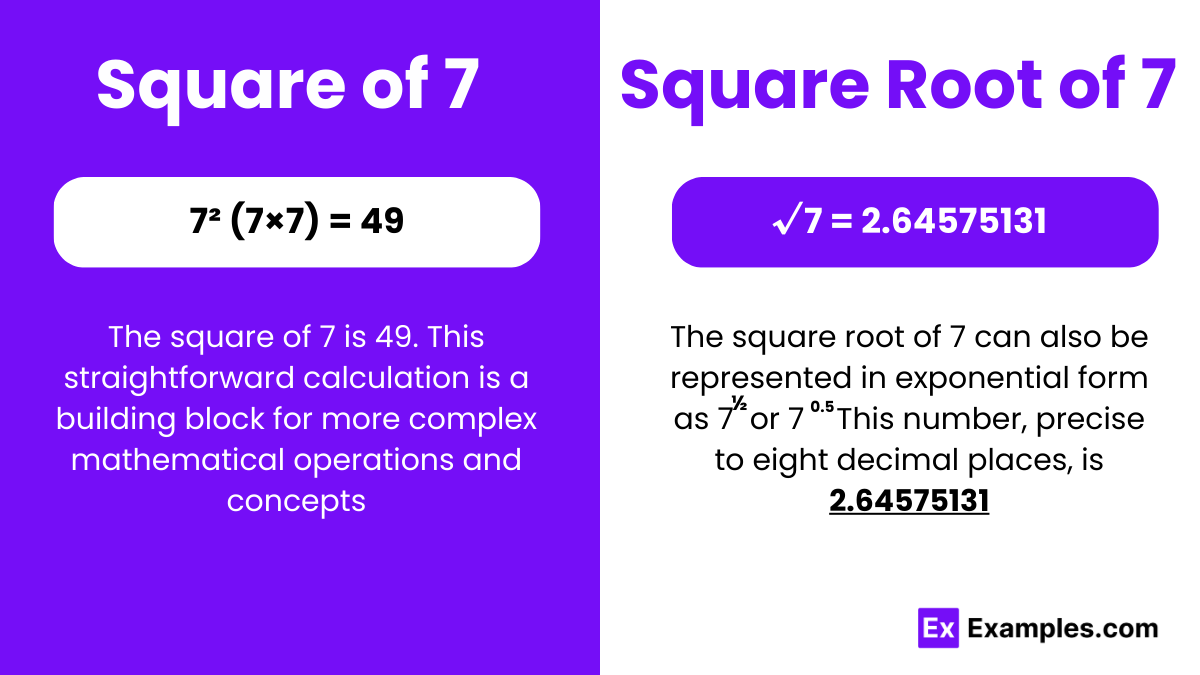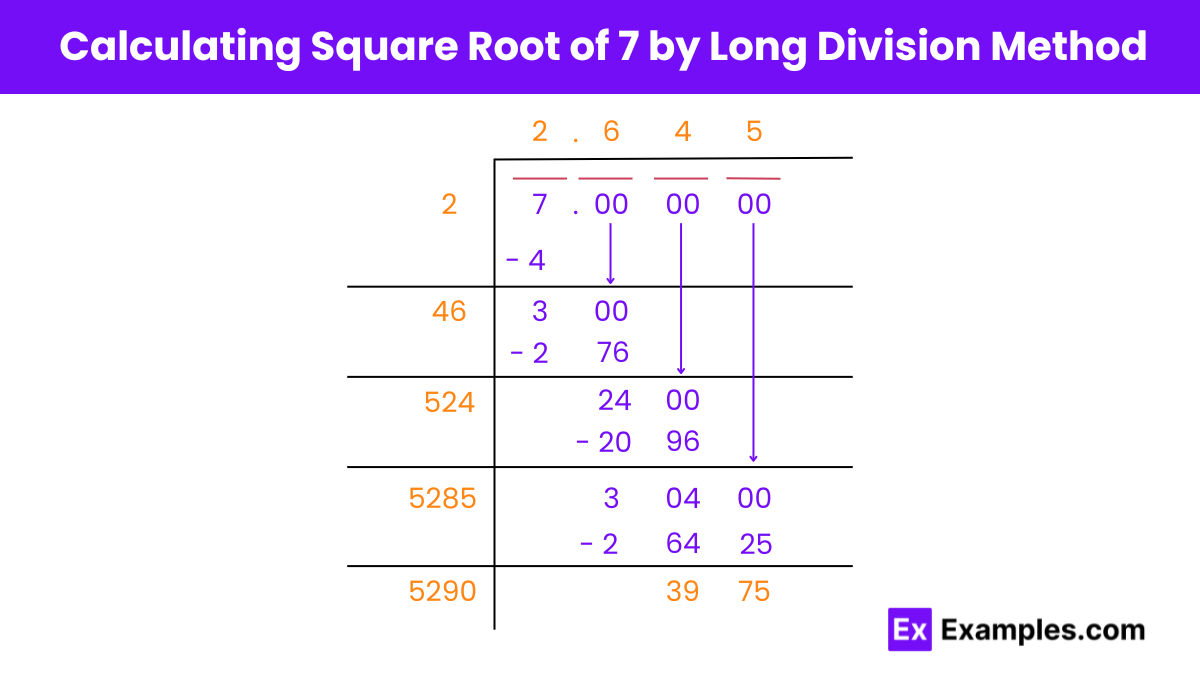What is the square of 7?
45
49
52
76

The square of 7, denoted as 7², is the result of multiplying the number 7 by itself. In mathematical terms, squaring a number means raising it to the power of 2. So, when we square 7, we get 49 as the result. In simple terms, the square of 7 is the area of a square with side length 7 units, making it a fundamental concept in arithmetic and geometry
or
√7=2.645 up to three places of decimal
The square root of 7, denoted as √7, is a value such that when multiplied by itself, yields 7. In simpler terms, it’s the number whose square equals 7. This value is irrational, meaning it can’t be expressed as a simple fraction and its decimal goes on indefinitely without repetition.
Understanding the square root of 7 is vital in geometry, algebra, and calculus. It helps in determining side lengths of squares, solving quadratic equations, and various calculus calculations.
Despite its simplicity, the square root of 7 embodies the complexity and beauty of mathematics, challenging conventional notions of numbers while offering insights into their intricacies.
Exponential Form:7^½ or 7^0.5
Radical Form:√7
The square root of 7 is an irrational number.
To understand why, let’s delve into the definitions of rational and irrational numbers.
Examples of rational numbers include 1/2, -3, and 5.
An irrational numbers cannot be expressed as a simple fraction of two integers. Their decimal representations are non-repeating and non-terminating.
Examples of irrational numbers include √2, π (pi), and √3.
When considering the square root of 7, it becomes apparent that it falls into the realm of irrationality. Unlike rational numbers, it cannot be expressed as a simple fraction. Attempting to represent it as a decimal reveals its infinitely expanding and non-repeating nature. The decimal representation of √7 continues indefinitely without settling into a predictable pattern. The irrationality of the square root of 7 is not just a mathematical curiosity but a fundamental property with significant implications. It underscores the inherent complexity and richness of the number system. While rational numbers offer straightforward representations, irrational numbers like the square root of 7 introduce layers of intricacy and depth to mathematical discourse. In summary, the square root of 7 stands as an exemplar of irrationality in the number system. Its inability to be expressed as a simple fraction and its infinitely expanding decimal representation affirm its classification as an irrational number, highlighting the diversity and complexity inherent in mathematical concepts.
To find the value of √7 in an easy and understandable way, try the following simple estimation method:

The long division method is a manual technique used to find the square root of a number. Here’s a detailed explanation of how to find the square root of 7 using this methods:
Using the long division method, we can approximate the square root of 7 manually, step by step, without the need for a calculator or advanced mathematical techniques.
7 Is Not a Perfect Square Root
A perfect square root is a number that can be expressed as the product of an integer multiplied by itself. For instance, 4 (2 × 2) and 9 (3 × 3) are perfect square roots.
However, when we examine 7, we find that it cannot be expressed as the product of two identical integers. There are no integers x such that x × x equals 7.
Therefore, 7 is not a perfect square root. It doesn’t have an integer square root. While it does have a square root (√7), it’s an irrational number and not the result of multiplying any whole number by itself.
Is √ 7 a real number?
Yes, the square root of 7, denoted as √7, is a real number. A real number is any number that can be found on the number line, including both rational and irrational numbers. Since √7 exists on the number line and is not an imaginary number (which involve the square root of negative numbers), it is classified as a real number.
Is 7 an integer yes or no?
Yes, 7 is an integer. An integer is a whole number that can be positive, negative, or zero. Since 7 is a whole number and not a fraction or a decimal, it falls under the category of integers.
What is the square root of 7 between?
The square root of 7 lies between the integers 2 and 3. While the exact value of √7 is approximately 2.645751311, it’s important to note that it falls between the perfect squares of 2 (which is 4) and 3 (which is 9). Therefore, we can say that the square root of 7 is greater than 2 but less than 3.
Text prompt
Add Tone
10 Examples of Public speaking
20 Examples of Gas lighting
What is the square of 7?
45
49
52
76
What is the square root of 49?
5
6
7
8
Which of the following represents the square root of 7?
2.45
2.65
2.55
2.75
What is the approximate value of the square root of 7 rounded to two decimal places?
2.63
2.64
2.65
2.66
Find the square of 7.
40
46
49
52
Identify the square root of 7 among the following values.
2.6
2.7
2.8
2.9
Calculate the square root of 7.
2.64
2.54
2.44
2.34
What is the square of 7?
46
47
48
49
Which number, when squared, gives 49?
5
6
7
8
The square root of which number is closest to 2.65?
5
6
7
8
Before you leave, take our quick quiz to enhance your learning!

